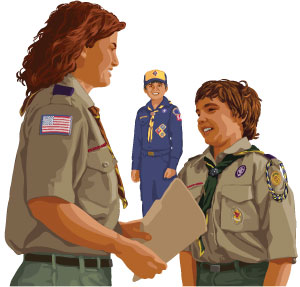
Hail to the Chief
Secrets for creating the real leaders of your den.
Illustration by Chris Lyons
In the early days of Cub Scouting, den leaders were optional. Den chiefs were not. That soon changed, but the den chief, a Boy Scout or Venturer who works with a Cub Scout or Webelos Scout den, remains a key member of the den leadership team.
 Pack 114 in Littleton, Colo., had three den chiefs last year, including a Life Scout (and Pack 114 alumnus) who virtually grew up with his Webelos Scouts over four years. “Giving back to an organization that you’ve graduated from is a special thing,” says Cubmaster Scotty Nash. “The impact these three had on our organization, as well as on the Scouting movement, is irreplaceable.” Still, don’t assume such a positive effect happens automatically.
Pack 114 in Littleton, Colo., had three den chiefs last year, including a Life Scout (and Pack 114 alumnus) who virtually grew up with his Webelos Scouts over four years. “Giving back to an organization that you’ve graduated from is a special thing,” says Cubmaster Scotty Nash. “The impact these three had on our organization, as well as on the Scouting movement, is irreplaceable.” Still, don’t assume such a positive effect happens automatically.
Instead, it relies on how you enlist, instruct, and involve your den chiefs. As you talk with Scoutmasters about potential den chiefs, make sure they understand what you’re looking for.
“The best thing you can do is ask, ‘Does he do a good job working with younger boys in his troop?’” says Sandra Lee, a longtime Cub Scout trainer from Lenoir City, Tenn.
If so, he’ll likely be an effective den chief—even if he’s just a couple of years older than his charges. “The right boy is the key,” Lee says.
The conversation shouldn’t end with the Scoutmaster, though. Julia Nicholas, who has trained hundreds of den chiefs in the Greater St. Louis Area Council, promotes the involvement of the Scout’s parents as well. “There has to be a sit-down with that young man, his parents, and the Scoutmaster so he understands his role,” she says. And the parents need to understand the extra demands on the Scout’s time.
Next comes instruction. The den chief’s success depends on training. New den chiefs should be encouraged to take the online training right away at the BSA’s Online Learning Center, olc.scouting.org. Then, they should plan to attend a council-level den chief training conference, which helps them understand the elements of a meeting, how to lead games and activities, and what makes Cub Scout-age boys tick. And Nicholas thinks den leaders and Cubmasters should attend, too.
“This is the first time that many Cubmasters have seen that a boy can lead,” she says. “That’s what we show them through using youth instructors in our sessions.”
Having adults involved in those sessions also prevents a common problem. “Sometimes a boy will go to den chief training and become a den chief, but the den leader doesn’t know how to use him,” Lee says. Which brings us to step three: Give the den chief stuff to do.
Nicholas recommends you hold a brief huddle after each den meeting to prepare for the next. “Set out a clear plan for what the den chief will be responsible for the next time, whether it’s helping the Cub Scouts practice an opening ceremony for the pack meeting or a hands-on experience with an activity badge,” she says.
Afterward, follow up with a phone call, an e-mail, or even a Facebook message. “They’re more apt to look at their e-mail than return a phone message,” Nicholas says. “That’s what they’re used to. The adult has to adapt to what the boys are doing.”
We know that sounds like a lot of work, but the results will surprise you, says Pack 114’s Nash. “The boys don’t see the den chiefs as parents but as real Boy Scouts they can strive to be like. And the leaders and parents respect these Boy Scouts, learn a bit about the program themselves, and see what the program can do for their own sons. Finally, the den chiefs themselves hone the leadership skills they’ll continue to use in the pack, in the troop, and throughout their lives.”